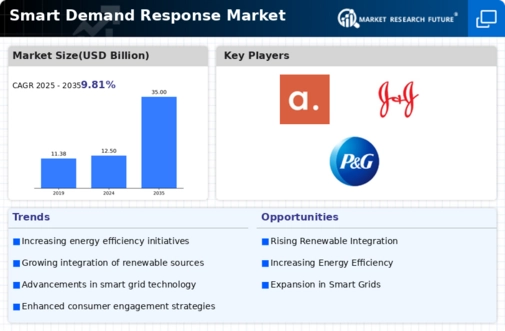Growing Energy Demand
The Global Smart Demand Response Market Industry is experiencing a surge in energy demand driven by urbanization and industrialization. As populations grow, the need for efficient energy management becomes paramount. In 2024, the market is projected to reach 12.5 USD Billion, reflecting the urgency for innovative solutions to balance supply and demand. This growth is further fueled by the increasing adoption of smart technologies, which facilitate real-time energy consumption monitoring. Governments worldwide are recognizing the necessity of demand response programs to enhance grid reliability and reduce peak load pressures, indicating a robust trajectory for the industry.
Market Growth Projections
The Global Smart Demand Response Market Industry is poised for substantial growth in the coming years. With a projected market size of 12.5 USD Billion in 2024 and an anticipated increase to 35 USD Billion by 2035, the industry is expected to witness a compound annual growth rate of 9.81% from 2025 to 2035. This growth trajectory suggests a robust demand for innovative demand response solutions as utilities and consumers alike seek to optimize energy usage and enhance grid reliability. The increasing integration of smart technologies and regulatory support further underscores the potential for significant advancements within the market.
Technological Advancements
Technological innovation is a key driver of the Global Smart Demand Response Market Industry. The proliferation of smart meters, IoT devices, and advanced analytics enables consumers to manage their energy usage more effectively. These technologies facilitate real-time data collection and analysis, allowing for more responsive energy consumption patterns. As a result, the market is expected to grow significantly, with projections indicating a rise to 35 USD Billion by 2035. The integration of artificial intelligence and machine learning into demand response systems further enhances their efficiency, suggesting that ongoing technological advancements will continue to propel market growth.
Regulatory Support and Incentives
Regulatory frameworks play a crucial role in shaping the Global Smart Demand Response Market Industry. Governments are implementing policies that encourage the adoption of demand response technologies, providing financial incentives for both consumers and utilities. These initiatives aim to promote energy efficiency and reduce greenhouse gas emissions. For instance, various countries have established mandates requiring utilities to integrate demand response into their operational strategies. This regulatory support not only fosters market growth but also aligns with global sustainability goals, suggesting that the industry could see a substantial increase in investment and participation in the coming years.
Increased Focus on Renewable Energy
The transition towards renewable energy sources is significantly influencing the Global Smart Demand Response Market Industry. As countries strive to meet their renewable energy targets, demand response programs are becoming essential for integrating intermittent energy sources like solar and wind. These programs help balance supply and demand, ensuring grid stability while maximizing the use of clean energy. The growing emphasis on sustainability and carbon reduction is likely to drive investments in demand response technologies, potentially leading to a compound annual growth rate of 9.81% from 2025 to 2035. This trend indicates a promising future for the industry as it aligns with global energy transition goals.
Consumer Awareness and Participation
Consumer awareness regarding energy consumption and its environmental impact is rising, which is positively affecting the Global Smart Demand Response Market Industry. As individuals become more conscious of their energy usage, they are increasingly willing to participate in demand response programs. This shift is evident in the growing number of residential and commercial users who opt for smart home technologies that enable them to manage their energy consumption proactively. The increased participation of consumers in demand response initiatives not only enhances grid reliability but also contributes to overall market growth, indicating a shift towards more sustainable energy practices.













